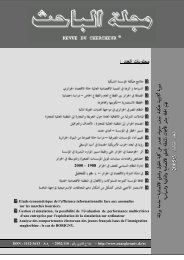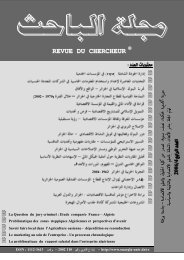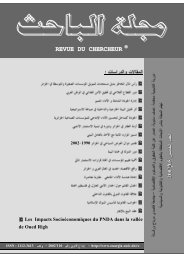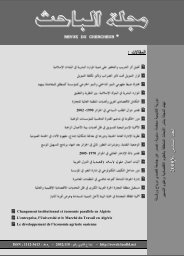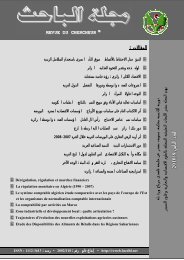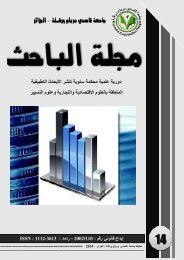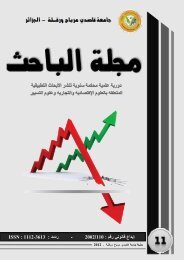El-BAHITH REVIEW Number 09 _ University Of Ouargla Algeria
Annual refereed journal of applied reserch in economic, commercial and managment sciences
Annual refereed journal of applied reserch in economic, commercial and managment sciences
You also want an ePaper? Increase the reach of your titles
YUMPU automatically turns print PDFs into web optimized ePapers that Google loves.
_______________________________________________________________________________________________________________________________________<br />
مجلة الباحث – عدد 2011 / <strong>09</strong><br />
adopted to the data in Table A.1 of the Appendices to estimate the model in equation (1). In the<br />
next section we report the empirical results.<br />
4. The Empirical Results :<br />
In this section we report the empirical results. To measure the degree and direction of<br />
the linear association between domestic savings and its determinants, Person’s correlation<br />
coefficients were calculated as reported in table (1), where figures inside the brackets are the<br />
t-ratios of the estimated coefficients.<br />
These correlation results reveal that African domestic savings are positively correlated with<br />
income and negatively with commercial banks deposit rate and the age dependency ratio. However,<br />
while the correlation coefficient with respect to income is significant at 1% level , the other<br />
coefficients are not statistically significant.<br />
Applying OLS technique to a log-linear form of equation (1) we obtained the results<br />
reported in table (2), where figures inside the brackets are the t-ratios of the estimated elasticities .<br />
It is clear from these results that all equations are significant at the 0.01 level as<br />
indicated by the value of their F-ratios. The results also suggest that on average over 40% of the<br />
variations in savings are explained by the explanatory variables. Moreover, in line with the<br />
correlation results, the elasticity of savings with respect to real per capita income turned out to be<br />
the only significant parameter. Furthermore, in all equations the constant term and the coefficient<br />
of real per capita income turned out to have the signs as postulated by economic theory. Equation<br />
(4) is the most significant equation as indicated by the value of F-ratio. The remained un explained<br />
variations in African savings may be attributed to the heavy tax burden, or to the African<br />
population behavior , and the age distribution .<br />
All in all , these results strongly support the theoretical argument which identified income as<br />
an important determinant of savings (Burrows and Theodor 1974, Samuelson 1976, Leavačic<br />
1976, Noel 1980, and Harvey 1977, 1985), while they reject the existence of a relationship<br />
between savings, interest rate (Leavačic 1976 and Giovannini, 1983), and dependency ratio in<br />
LDCs.<br />
5. Conclusion<br />
This study examined the response of domestic savings in a set of African countries to its most<br />
important determinants, namely income, commercial banks’ interest rate, and the age dependency<br />
ratio. For this purpose Ordinary Least Squares regression technique is applied to cross-section data<br />
-27-





